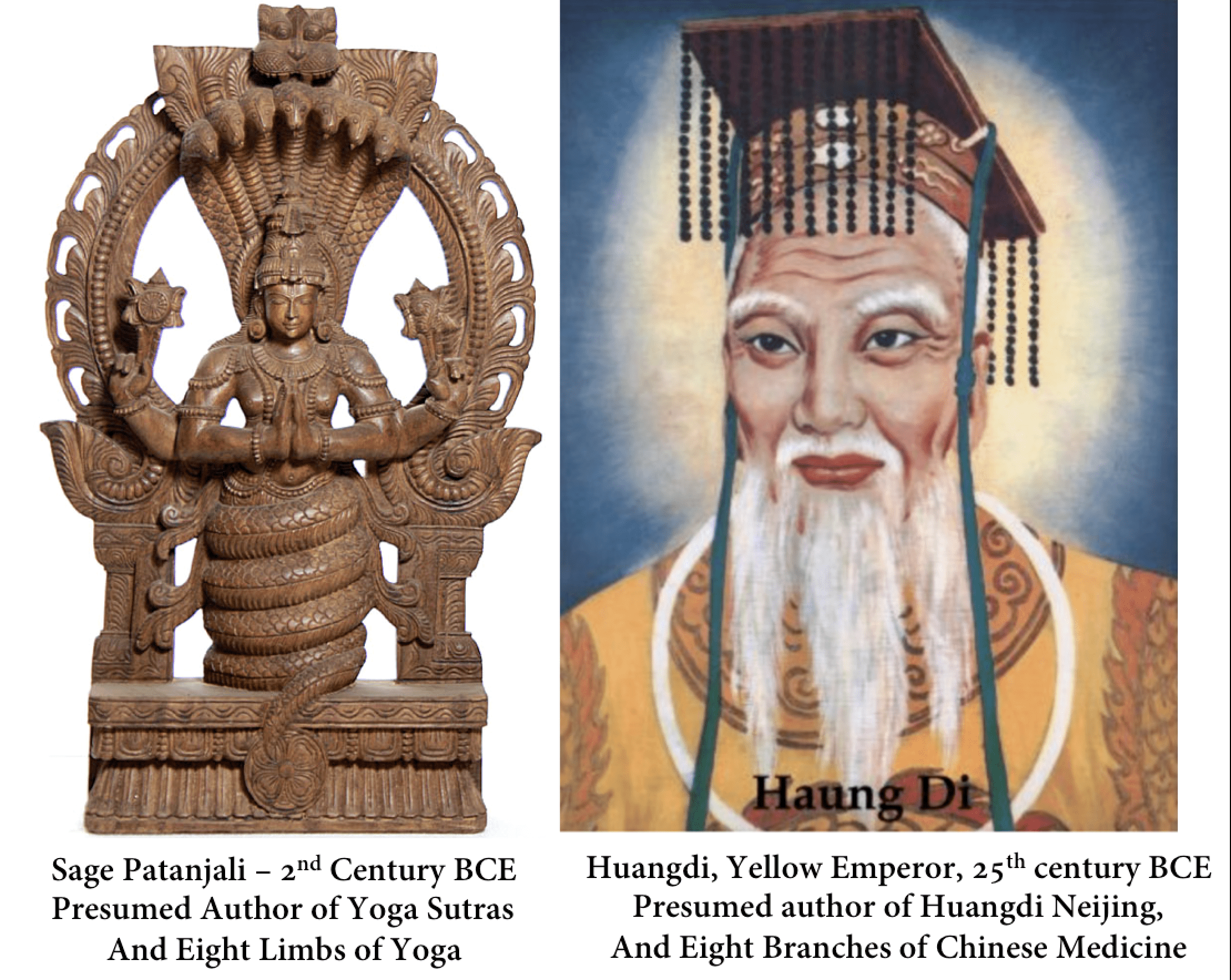 In ancient times, both Chinese and Yogic traditions developed sacred writings on the highest spiritual practices. It turns out both systems have eight branches, and they are somewhat different. Shall we compare them? In this article we look at the Eight Branches of Chinese Medicine, and the Eight Limbs of Yoga. In Eastern wisdom, medical practice and spiritual work were considered one and the same path. By noticing what the ancients believed to be the most important elements of a spiritual life, we can learn a lot about ourselves and the world around us! The 8 Yogic Branches originate from the Yoga Sutras written by Patanjali in the 2nd or 4th centuries BCE. The Chinese 8 branches may go back even further to Huangdi, the Yellow Emperor in about 2,600 BCE.
In ancient times, both Chinese and Yogic traditions developed sacred writings on the highest spiritual practices. It turns out both systems have eight branches, and they are somewhat different. Shall we compare them? In this article we look at the Eight Branches of Chinese Medicine, and the Eight Limbs of Yoga. In Eastern wisdom, medical practice and spiritual work were considered one and the same path. By noticing what the ancients believed to be the most important elements of a spiritual life, we can learn a lot about ourselves and the world around us! The 8 Yogic Branches originate from the Yoga Sutras written by Patanjali in the 2nd or 4th centuries BCE. The Chinese 8 branches may go back even further to Huangdi, the Yellow Emperor in about 2,600 BCE.
 The Eight Branches of Chinese Medicine
The Eight Branches of Chinese Medicine
- Meditation, such as Internal Alchemy and Small Heavenly Circuit
- Movement (Qigong, Gong Fu, Tai Chi)
- Diet & Nutrition
- Bodywork, Tui Na
- Cosmology, BaGua, I-Ching
- Feng Shui and Astrology
- Herbal Medicine
- Acupuncture
Huang-di, the Yellow Emperor, ruled China from 2697 – 2597 BCE. He co-authored the Huang Di Nei Jing, the oldest known medical text, a conversation with his physician Qi Bo. The HuangDi Neijing is 4,500 years old. During the time of the Yellow Emperor, Meditation and Qigong were considered the two most essential branches of medicine, the most subtle, and therefore the most powerful, as they arise out of a personal practice. Medical students were trained in these two branches before studying anything else. Acupuncture or herbs were last, considered invasive emergency measures when all other remedies failed.
The Ancient Chinese Medical System
Chinese doctors were paid only as long as their patient enjoyed good health. If a person became sick, by law the doctor was required to give free treatments until health was regained. For every patient that died, a red lantern was hung outside the treatment center to warn others of the doctor’s failure.
There were 3 kinds of doctors:
- The lowest level doctors treated patients when they were sick, using acupuncture and herbs, considered the most invasive emergency methods.
- Advanced doctors diagnosed and treated disease before it manifested physically.
- The highest level of doctor had no patients and gave no medical treatments.
These great master teachers imparted the Way of the Dao to their students.
Modern Changes in Chinese Medicine
Throughout history, traditional Chinese medicine flourished. However in the late 1800’s under British influence, it became a symbol of old backward ways and a source of embarrassment to modern Chinese people. In 1912 the Kuomintang government formally adopted modern Western medicine and abolished Chinese medicine. Cities built modern hospitals, while in the countryside old ways continued. However In 1942 Mao completely outlawed traditional Chinese medicine as “outdated, superstitious and shamanic”. Many doctors and Qigong masters were imprisoned.
In the 1950’s under international pressure, Mao reinstated Chinese Medicine side by side with Western medicine. However it was revised and simplified into the two primary branches we know today: acupuncture and herbs, eliminating the other six branches. The new version of acupuncture de-emphasizes the complex internal pathways of the 12 main meridians, those points not accessible to needles, and less emphasis is given to the extraordinary meridians, the cosmic, ancestral channels.
“Heaven is of Yang. Earth is of Yin. The Sun is of Yang. The Moon is of Yin.”
from the Huangdi Neijing 2,700 BCE, earliest known medical book.
 What are the Eight Limbs of Yoga?
What are the Eight Limbs of Yoga?
- Yamas are restraints, ethical disciplines, or moral codes including ahimsa (non-violence or non-harming), satya (truthfulness), asteya (non-stealing), bramacharya (sexual restraint), and aparigraha (non-possessiveness).
- Niyamas are rules of conduct and personal behavior including saucha (purity), santosha (contentment), tapas (discipline or austerity), svadhyaya (spiritual studies), and Ishvara Pranidhana (constant devotion to God).
- Asana means yoga postures to prepare the body for meditation.
- Pranayama breathing techniques to control prana or vital life force.
- Pratyahara, withdrawal of the senses internally.
- Dharana refers to concentration of the mind.
- Dhyana means “sustained attention” or contemplation. In the West we use the word meditation, although the specific practices are mostly unknown. Countless lineages of meditation exist to refine the inner essence, including Chakras, Breath, Mantra, Heart, Mindfulness, and Mindlessness.
- Samadhi is merging with the divine, the culmination of a spiritual practice.
The practice of the Eight Limbs of Yoga is referred to as practicing Raja yoga, or the “Royal Path”. Raja yoga creates stillness and contemplation. There are countless other types of Yoga, mostly recent inventions and adaptations, including Yin Yoga, Hatha Yoga, Vinyasa, Iyengar, Tantra, Viniyoga, Ashtanga, Prenatal Yoga, Water Yoga, etc.
The Eight Limbs of Yoga Come from the Sutras of Patanjali
The eight Limbs of Yoga come from the Yoga Sutras compiled or written by Sage Patanjali, who lived in the 2nd or 5th century BCE. Patanjali’s goal was to describe practices to still the mind and merge into oneness with the divine. When we awaken to divine essence, we are able to live fully from a place of authenticity. We are able to discern who we really are and what our purpose is. We don’t have to look out into the exterior to determine right from wrong. All the answers are found within.
“It is only when the correct practice is followed for a long time, without interruptions and with a quality of positive attitude and eagerness, that it can succeed.” ― Patañjali, Yoga-Sutras


